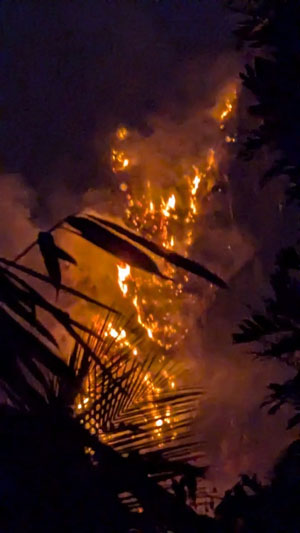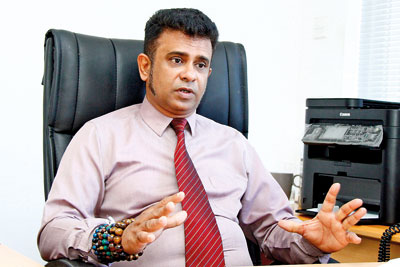News
Forest fires on the rampage in the wet zone
View(s):By Dilushi Wijesinghe
By late August, Sri Lanka had already counted 147 forest fires this year. That is an average of two a day, Director and Media Spokesman of the Disaster Management Centre Pradeep Kodippili told the Sunday Times.
The DMC says the numbers are neither unusually high nor low when compared with the past decade. Yet the frequency and the scale in districts like Badulla, Matale and Ratnapura have left officials worried.

A forest fire in Ella
“We have had 30 fires in August alone,” Mr. Kodippili said. “Most of them are in Badulla, Matale, Nuwara Eliya and Ratnapura. Ella has also become a hotspot. The environmental cost is far worse than the economic cost.”
Ratnapura recently witnessed a fire so extensive that helicopters had to be deployed. “This year, the DMC will purchase fire beaters and deploy them where possible,” he explained. “But the truth is that we do not have enough people to prevent or chase away arsonists. That is one reason why we are failing to control the problem.”
Arson is at the root of many blazes. The DMC estimates at least ten deliberate fires a month. “People’s mindsets do not change,” Mr. Kodippili observed. “That is why they keep setting fire to forest patches, sometimes to clear land, sometimes to hunt, sometimes for no reason at all.”
The absence of strong deterrents has emboldened culprits. “The laws against arsonists should be tighter,” he insisted. “At the moment, there is little fear of consequences.”
Still, the Centre has been trying to create awareness. “We have even conducted house-to-house campaigns,” he said. “We also operate a trilingual hotline – 117 – where the public can report any incident.”
The challenge is compounded by fluctuating annual patterns. “In some years the numbers are high; in some years they are low,” he said. “This year, it is average. But averages mean nothing when you see the damage on the ground.”
Satellite technology is being used to improve tracking. The DMC now collaborates with NASA, receiving real-time data from satellites that feed into Sri Lanka’s Emergency Operations Centre. “This allows us to monitor where fires break out and respond quickly,” Mr. Kodippili said.
Statistics collected by the DMC paint a stark picture. Between January and late August, Badulla alone recorded 34 fires, the highest in the country. Matale followed with 27, and Kandy with 23. Monaragala saw 14, Ratnapura 15 and Nuwara Eliya 8. Smaller numbers were reported in districts including Gampaha, Kurunegala, Polonnaruwa, Ampara and Hambantota.

Pradeep Kodippili. Pic by Indika Handuwala
The Centre highlights that these fires extract a silent toll on biodiversity. “When people talk about forest fires, they think about the economic loss,” Mr. Kodippili said. “But the environmental cost – the loss of trees, the destruction of habitats, the damage to watersheds – is far greater. These are things that take decades to recover.”
Officials have come to terms with the reality that prevention is more difficult than response. “We can beat down a fire. We can control its spread. But to prevent one is much harder, because you cannot police every mountain, every slope,” said Mr. Kodippili. “And when people themselves are responsible, it becomes a question of culture and enforcement.”
“If people see a fire, they must call 117. If they see someone lighting one, they must report it. Unless society joins in, the destruction will continue,” he warned.
Police Media Spokesman ASP F.U. Wootler said that such cases are handled under the Penal Code. “If it is arson, or if someone deliberately sets bushes alight and it becomes a bush fire, the Sri Lanka Police will act under the Penal Code,” he said. “There are fines and even prison terms depending on the severity. But when it comes to fires inside forest reserves, the Forest Department has authority as well. The police take on the legal side of enforcement.”
Beyond the Penal Code, the Forest Conservation Act prescribes explicit penalties, as igniting a fire for any reason in a forest area is an offence. The severity of punishment depends on the category of land destroyed. In the case of a forest reserve – areas set aside by the government as wilderness – the penalty ranges from a fine of Rs 10,000 to Rs 100,000, or a five-year jail term, or both.
For conservation forests, which are preserved for future generations, the punishment is harsher: fines between Rs 20,000 and Rs 200,000, or up to seven years’ imprisonment, or both. The Fauna and Flora Protection Ordinance and the Forest Conservation Ordinance are also applied, with fines and sentences determined by court order.
The Department of Wildlife Conservation (DWC) has also been taking preventive measures within its own protected areas. “Normally, to stop forest fires, we cut fire belts,” said Director General Ranjan Marasinghe. “At Horton Plains, for instance, this has been one of our main strategies.”
Investigations by the department have shown that fires are human made. “When we examined the stumps, we saw that most fires originated from people going there and using matchboxes for things like burning firewood,” Mr. Marasinghe explained. “We have a strict monitoring programme. Plastic bottles, matchboxes and lighters are not allowed into the forestland. If we suspect someone, we even carry out a body search. Because of that, we have not had such incidents recently.”
The department also restricts visitor movements. “People are not allowed to stay until sunset,” Mr. Marasinghe said. “And we have regulated entry for livelihood activities inside certain areas. Even motorcycles are not permitted.”
The best way to say that you found the home of your dreams is by finding it on Hitad.lk. We have listings for apartments for sale or rent in Sri Lanka, no matter what locale you're looking for! Whether you live in Colombo, Galle, Kandy, Matara, Jaffna and more - we've got them all!

